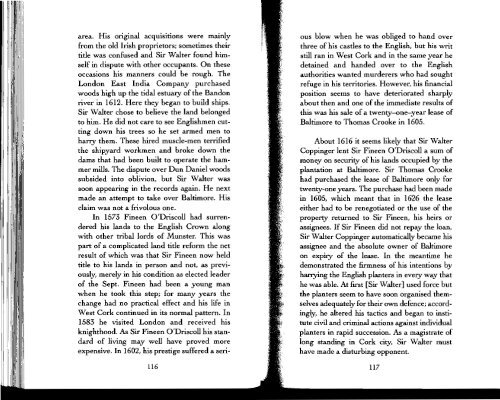Create successful ePaper yourself
Turn your PDF publications into a flip-book with our unique Google optimized e-Paper software.
area. His original acqUIsItIons were mainly<br />
from the old Irish proprietors; sometimes their<br />
title was confused and Sir Walter found himself<br />
in dispute with other occupants. On these<br />
occasions his manners could be rough. The<br />
London East India Company purchased<br />
woods high up the tidal estuary of the Bandon<br />
river in 1612. Here they began to build ships.<br />
Sir Walter chose to believe the land belonged<br />
to him. He did not care to see Englishmen cutting<br />
down his trees so he set armed men to<br />
harry them. These hired muscle-men terrified<br />
the shipyard workmen and broke down the<br />
dams that had been built to operate the hammer<br />
mills. The dispute over Dun Daniel woods<br />
subsided into oblivion, but Sir Walter was<br />
soon appearing in the records again. He next<br />
made an attempt to take over Baltimore. His<br />
claim was not a frivolous one.<br />
In 1573 Fineen O'Driscoll had surrendered<br />
his lands to the English Crown along<br />
with other tribal lords of Munster. This was<br />
part of a complicated land title reform the net<br />
result of which was that Sir Fineen now held<br />
title to his lands in person and not, as previously,<br />
merely in his condition as elected leader<br />
of the Sept. Fineen had been a young man<br />
when he took this step; for many years the<br />
change had no practical effect and his life in<br />
West Cork continued in its normal pattern. In<br />
1583 he visited London and received his<br />
knighthood. As Sir Fineen O'Driscoll his standard<br />
of living may well have proved more<br />
expensive. In 1602, his prestige suffered a seri<br />
116<br />
ous blow when he was obliged to hand over<br />
three of his castles to the English. but his writ<br />
still ran in West Cork and in the same year he<br />
detained and handed over to the English<br />
authorities wanted murderers who had sought<br />
refuge in his territories. However, his financial<br />
position seems to have deteriorated sharply<br />
about then and one ofthe immediate results of<br />
this was his sale ofa twenty-one-year lease of<br />
Baltimore to Thomas Crooke in 1605.<br />
About 1616 it seems likely that Sir Walter<br />
Coppinger lent Sir Fineen O'Driscoll a sum of<br />
money on security of his lands occupied by the<br />
plantation at Baltimore. Sir Thomas Crooke<br />
had purchased the lease of Baltimore only for<br />
twenty-one years. The purchase had been made<br />
in 1605, which meant that in 1626 the lease<br />
either had to be renegotiated or the use of the<br />
property returned to Sir Fineen, his heirs or<br />
assignees. If Sir Fineen did not repay the loan,<br />
Sir Walter Coppinger automatically became his<br />
assignee and the absolute owner of Baltimore<br />
on expiIy of the lease. In the meantime he<br />
demonstrated the firmness of his intentions by<br />
harrying the English planters in every way that<br />
he was able. At first [Sir Walter] used force but<br />
the planters seem to have soon organised themselves<br />
adequately for their own defence; accordingly,<br />
he altered his tactics and began to institute<br />
civil and criminal actions against individual<br />
planters in rapid succession. As a magistrate of<br />
long standing in Cork city, Sir Walter must<br />
have made a disturbing opponent.<br />
117


